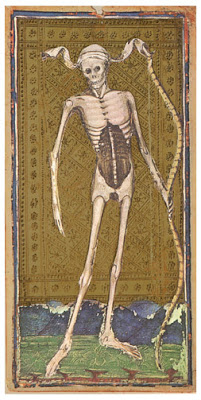Back in the 15th century, tarot cards were used
to play a game known as Trionfi, then
later Tarocchi, Tarocchini, and other names. In France, the game was known as Tarot. Decks consisted of 78 cards – 22
trump cards, of which Death was one, as well as 56 minor or pip cards numbering
1 through 10, plus four face cards – the King, Queen, Knight, and Page (or Jack).
According to most sources, tarot cards became associated
with cartomancy in the 18th century, but I wonder if they weren’t
used for divination earlier. Here’s an intriguing fact. Of the remaining cards in
the Visconti-Sforza collections, only two trump cards (or Major Arcana) are
missing: the Devil and the Tower. Both cards depict ill circumstances (although
in modern day interpretations, they also have less dire meanings). Back in the middle ages, the Devil card might have been seen as a literal indication of the Devil and his works, a
foretelling of evil deeds, terrible loss, and damnation. As for the Tower, it pointed to accidents, disaster,
and ruin; the mighty struck down by God on high for their power
and pride. (Again, modern interpretations allow room for positive outcomes.)
All said, it intrigues me that these two cards – the Devil and the Tower –
are missing from the Visconti-Sforza collection. Why? Were they destroyed
because some medieval soul feared what they might bring? Or could they have been used
in a magical rite? And if they were, to what end? What was happening in Europe in
the mid-1400’s?
In 1440, the printing press with movable type was born,
which, on the surface, was a good thing, but also meant
the birth of greater independent thought. Humanism encouraged the study of
history and literature focusing on the
ancient world, which would have loosened the Church's grip on the medieval mind - not a good thing in its opinion. In 1453, Constantinople fell to the Ottomans, ending the
Byzantine Empire. In 1462, Vlad the Impaler invaded Bulgaria and impaled over
23,000 Turks and Bulgarians in what may have been a strike for Christendom (but more likely, Vlad was consolidating his own position). If these events were linked to dark magic, they would
make for an interesting story.
On a happier and more personal note, one of my best memories is of
Robert Zelazny, who wrote many wonderful books, including his series, The Chronicles of Amber, of which The Nine Princes in Amber is my favourite. The Chronicles uses tarot cards as magical artifacts. The characters
are represented through various trumps; the cards are also portals for travel and communication. Apparently, Roger was fascinated with the tarot (as am I). As Guest of Honour, he attended a convention here in Edmonton in 1993. After I
was introduced to him, he asked me if I wrote. I’d just had my first
short story published in On Spec Magazine.
He had a copy of the issue and said he looked forward to reading my story. With that
one kind comment, I learned that great writers are also great people, generous
and supportive of newcomers. When he died in 1995, I was sad to hear of it. We lost a great writer and a great human being in his passing.
His series also inspired a modern day tarot deck - the Amber deck - created by French artist Florence Magnin. Here is her version of the Death card:
His series also inspired a modern day tarot deck - the Amber deck - created by French artist Florence Magnin. Here is her version of the Death card:
Until next time, may inspiration strike you.
Happy writing. - Susan.
Happy writing. - Susan.


No comments:
Post a Comment